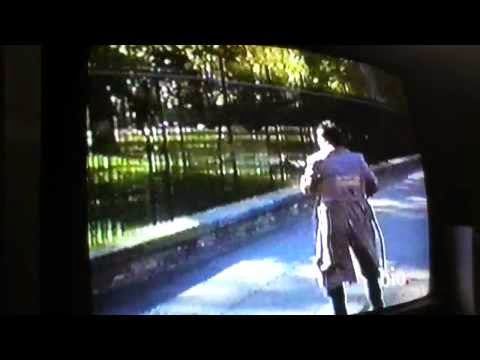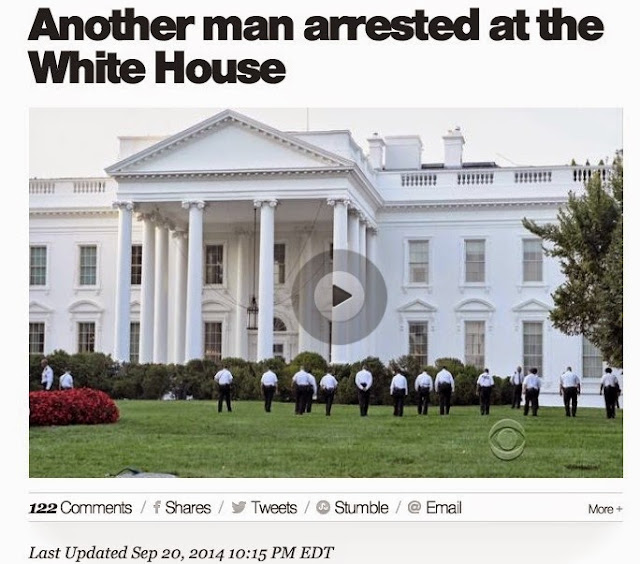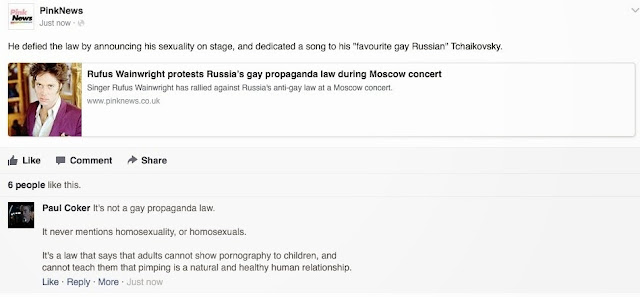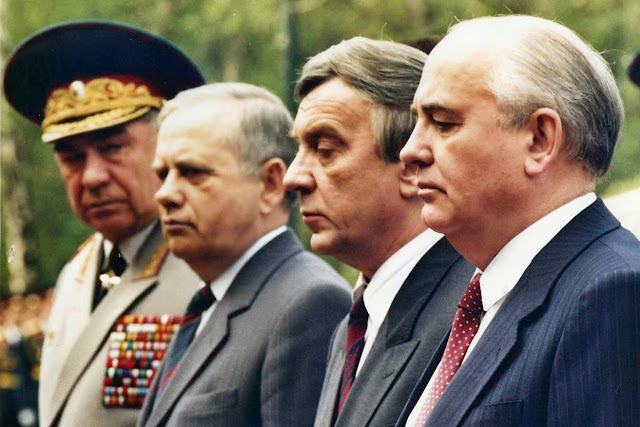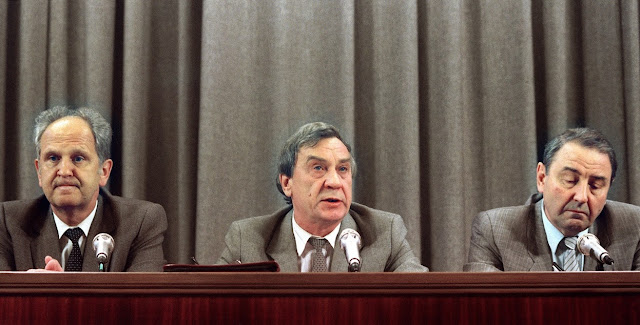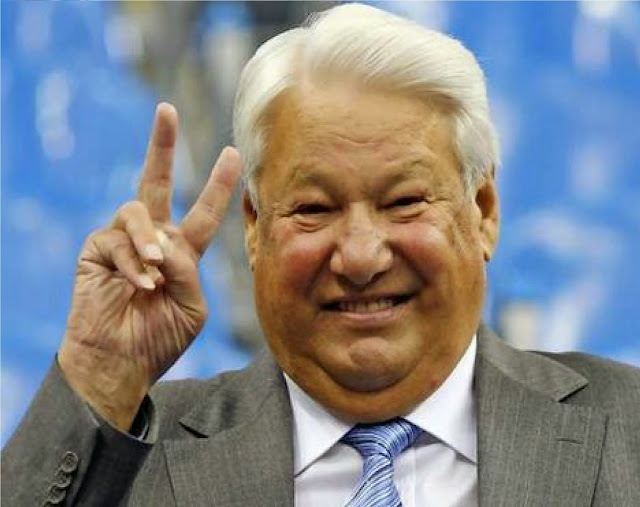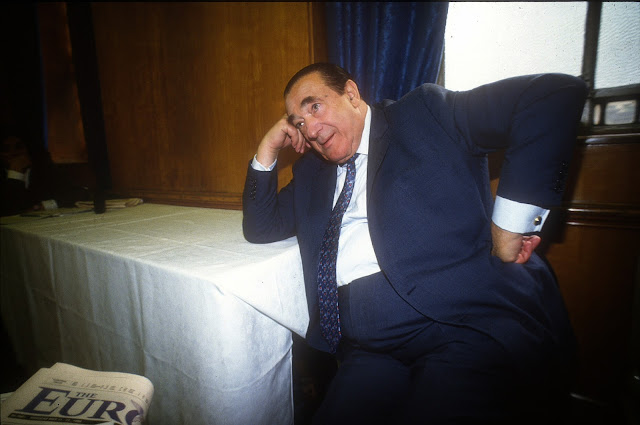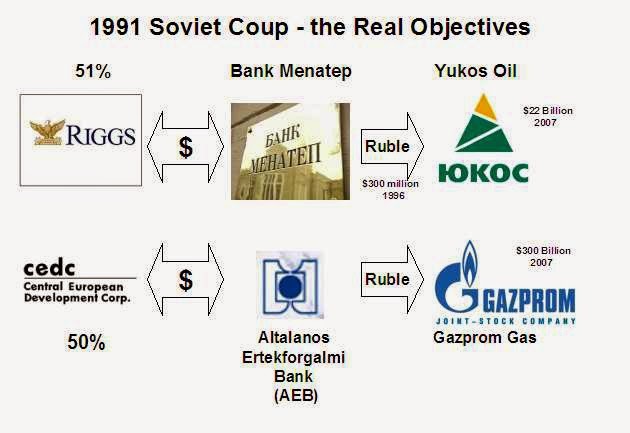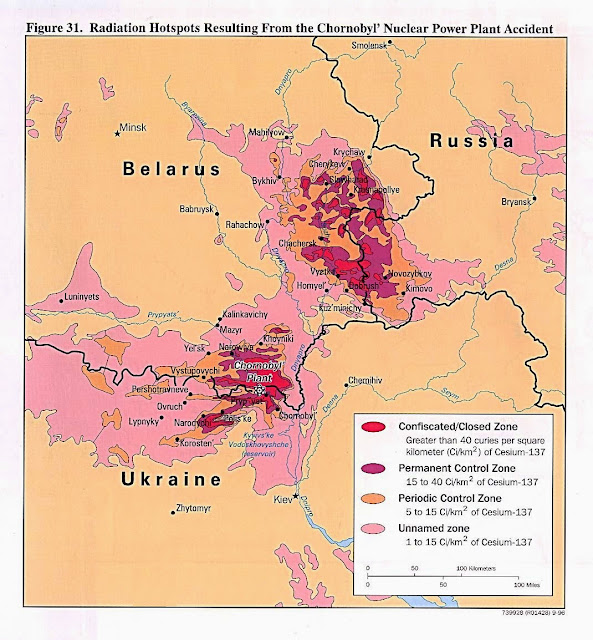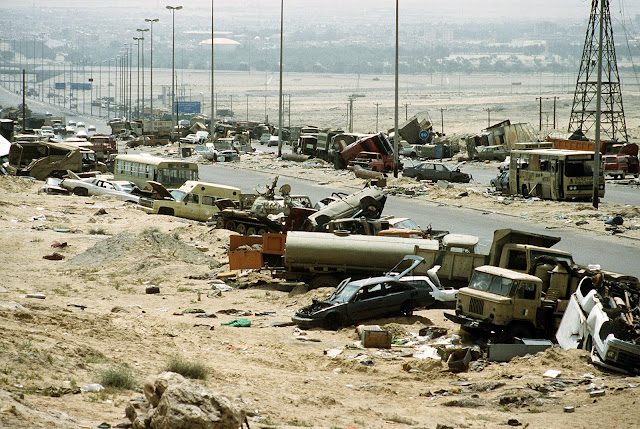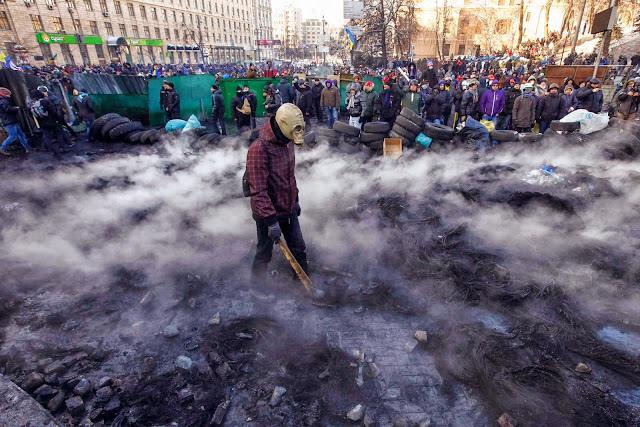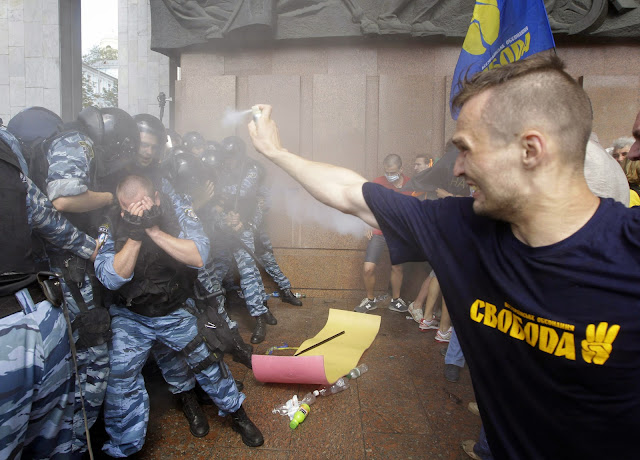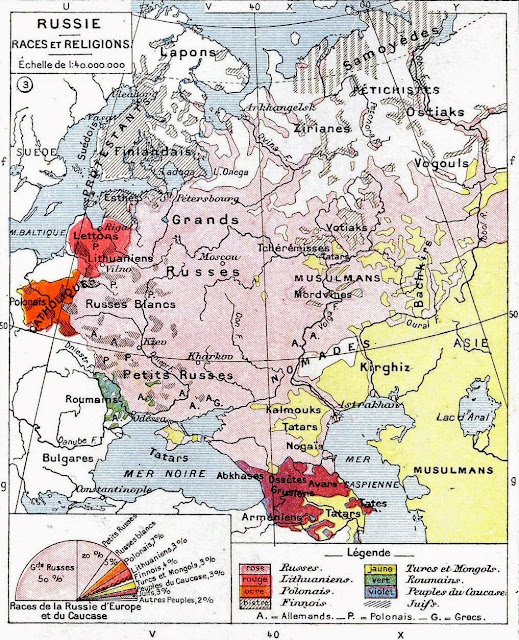"We are a wave of assassins throughout the world.''
Francisco Martin Duran, aka Trenchcoat Man
"If you walk up to the front gate of the White House and ask to speak to the President, they will say to you "No, go away"; if you then go around to another gate and ask to see the President, you are immediately picked up and taken away to St. Elizabth's Psychiatric Hospital.
They have an actual diagnosis for this, they have about 120 or so a year - they call them "White House Cases".
If you try to get into the White House, then you're delusional - and the reason that you're delusional is because they think the President of the the United States wants to help them - this is in writing."
- John Judge on the wave of would-be-Clinton Assassins,
October 1994
In 1994, gunman Francisco Martin Duran fired more than two dozen shots from a semiautomatic rifle at the White House.
(Duran was later convicted of trying to assassinate President Bill Clinton and was sentenced to 40 years in prison.)
"According to a criminal complaint, when Gonzalez was apprehended he told Secret Service agents he was "concerned that the atmosphere was collapsing" and needed to contact the president "so he could get word out to the people." "
- Associated Press.
He's from the Mind Control Facility at Fort Hood.
Something is about to happen...
Last Updated Sep 20, 2014 10:15 PM EDT
WASHINGTON -- A man who drove up to a White House gate and refused to leave was arrested on Saturday, the Secret Service said, less than 24 hours after another man jumped the fence and made it all the way into the presidential residence before being apprehended. The president and first family were not at home.
How did trespasser make it past White House front door?
The second incident started Saturday afternoon when a man approached one of the White House gates on foot, Secret Service spokesman Ed Donovan said. He later showed up at another gate in a car and pulled into the vehicle screening area. When the man refused to leave, he was placed under arrest and charged with unlawful entry. Officials have not released his identity.
CBS News correspondent Julianna Goldman reports that, according to Donovan, Saturday's incident doesn't appear to be a copycat of Friday night's intrusion.
Bomb technicians, fully suited, could be seen looking through a white four-door sedan with New Jersey plates and pulling out what appeared to be keys. Streets near the White House were temporarily closed as officers responded, but the White House was not locked down.
Intruder jumps White House fence, sparks evacuation
It wasn't immediately clear who the man was or why he was trying to enter the White House. President Obama, his wife and daughters were at Camp David, the presidential retreat in Maryland where the first family was spending the weekend.
[ Quote : "It's a good job there're no real terrorists - because you just told them that you missed him and where to find him." - John Judge ]
The pair of incidents in short succession heightened concerns about security at the White House, one of the most heavily protected buildings in the world.
Just minutes after Mr. Obama and his daughters had departed by helicopter Friday evening, a 42-year-old man hopped over the fence and darted across the lawn, ignoring officers' commands to stop, Donovan said. He managed to get through the doors of the North Portico, the grand, columned entrance that looks out over Pennsylvania Avenue.
The Secret Service identified the suspect as Omar Gonzalez [Muslim..?] of Copperas Cove, Texas. He was charged with unlawful entry into the White House complex and transported to a nearby hospital complaining of chest pain.
[Post-hypnotic suggestion, poison capsule, or an implant..?]
On a quiet cul-de-sac about an hour's drive from Waco, Texas, where Gonzalez was last known to have lived, former neighbors said he moved out roughly two years ago, explaining only that he had to get out of Copperas Cove, which sits next to the Fort Hood Army post.
Sgt. 1st Class David Haslach, who lives two doors down from Gonzalez's former home, said Gonzalez had been in the U.S. military and told Haslach he had received a medical discharge. He and another former neighbor, Elke Warner, both recalled him seeming paranoid in the months before he left town.
"At the end, he got so weird. He had motion detector lights put in," Warner said. She added that she last saw Gonzalez about a year and a half ago at a nearby camp site, where he was apparently living with his two dogs.
[He's apparently concerned therefore either about Organised Gangstalking or Alien Abduction]
(assuming of course that those are both not exactly the same thing.)
Attempts to reach Gonzalez or his relatives by phone were unsuccessful.
The breach triggered a rare evacuation of much of the White House, with Secret Service officers drawing their guns as they rushed staffers and journalists out a side door.
Officials had originally said that Gonzalez appeared unarmed as he sprinted across the lawn - potentially one reason agents didn't shoot him or release their service dogs to detain him. But, according to the complaint against Gonzalez that was read Saturday, he was carrying a two-and-a-half-inch folding knife with a serrated blade in his right front pocket, Goldman reports. He faces a weapons charge.
The embarrassing incident comes at a difficult time for the Secret Service, which is still struggling to rehabilitate its image following a series of allegations of misconduct by agents in recent years, including agents on Mr. Obama's detail.
The Secret Service has struggled in recent years to strike the appropriate balance between ensuring the first family's security and preserving the public's access to the White House grounds. Once open to vehicles, the stretch of Pennsylvania Avenue in front of the White House was confined to pedestrians after the Oklahoma City bombing, but officials have been reluctant to restrict access to the area further.
Last year, a 34-year-old dental hygienist tried to ram her car through a White House barrier before leading police on a chase that ended with her being killed. Her 1-year-old daughter was in the car but escaped serious injury.
"He kept a diary - and prior to that, he had never kept a diary before. It seems to me, that all these so-called political assassins keep diaries."
Governor George Wallace on Arthur Bremer
"We know Bremer wasn't a loner - something stinks about the whole thing"
First Lady Lurmilla Wallace
"Die, Die, Die, RFK Must Die"
Sirhan Sirhan's automatic writing
''I will finish what Hinckley started... RR must die... He [John Warnock Hinkley] has told me so in a prophetic dream. Sadly though, your death is also required. You will suffer the same fate as Reagan and others in his fascist regime.
You cannot escape.
We are a wave of assassins throughout the world.''
http://spikethenews.blogspot.com/2014/03/the-two-hinkleys.html
Man Charged with Clinton Assassination Attempt
By Toni Locy
The Washington Post
WASHINGTON
Francisco Martin Duran, the Colorado man who allegedly opened fire on the White House last month, was charged Thursday with attempting to assassinate President Clinton after several friends and co-workers told investigators that he had said he wanted to kill the president.
Even though those people have now come forward with the information, U.S. Attorney Eric H. Holder Jr. had harsh words for them Thursday during a news conference announcing Duran's indictment by a federal grand jury.
Calling their failure to report the threats before Duran came to Washington "very disturbing" and "unacceptable," Holder said, "When any American citizen has solid information that a person" intends to harm the president or any other public official, that citizen has "a civic and moral duty to come forward with that information before that tragedy occurs."
He said the incident could have had a disastrous outcome if it were not for the heroism of two tourists who tackled Duran as he allegedly attempted to reload a Chinese-made 7.62mm semiautomatic rifle. "We are truly in their debt," Holder said.
Duran, through his lawyer, assistant public defender Leigh Kenny, pleaded not guilty to the 11-count indictment.
Prosecutors Thursday filed a motion requesting that defense attorneys divulge whether they intend to use an insanity defense to the charges. Kenny has until Monday to respond. She could refuse and fight the request, which the prosecutors made because they want to know as soon as possible for strategic reasons whether Duran will claim he was insane at the time of the Oct. 29 shooting.
The addition of the attempted-assassination charge came after days of debate in the Justice Department and Holder's office over whether the evidence was strong enough to charge Duran with that offense. Conviction carries a maximum penalty of life in prison.
Duran, 26, a hotel upholsterer from Colorado Springs, allegedly fired at least 29 rounds at the White House, striking the building many times. Clinton, who had just returned from a trip to the Middle East, was not in sight but in the family quarters of the mansion watching a football game on television. No one was injured, although Pennsylvania Avenue was packed with tourists at the time.
To support the attempted-assassination charge, the prosecution is relying on the statements made to the FBI by several friends and co-workers of Duran who say he told them before he came to Washington that he intended to kill Clinton.
The evidence against Duran also includes numerous items seized from his truck, found parked near the White House after the shooting. In it, authorities found several hundred more rounds of ammunition, another weapon, poison-gas antidotes and numerous documents and letters allegedly written by Duran.
And investigators have a dramatic videotape of the shooting, made by a tourist, that shows Duran firing the rifle he had under his trench coat and attempting to reload as he was being tackled and subdued.
But another lawyer for Duran, chief public defender A.J. Kramer, revealed Thursday for the first time that one of the letters found in the truck makes no mention of Clinton by name or of any intention to harm him in any way. Lawyers for The Washington Post, The New York Times, and NBC argued Thursday for the public release of that letter.
Legally, prosecutors must prove two elements to win a conviction on an attempted-assassination charge. First, they must show that the defendant "specifically intended to kill" the president. That element can be proven with the statements of his co-workers and friends about his intentions, as well as any of his alleged writings.
Secondly, prosecutors must show he took "a substantial step" to carry out that intention. That could include buying a gun and firing it at the White House where he knew the president was, and driving to Washington with a truck loaded with supplies to carry out a specific plan.
Duran also is charged with four counts of assaulting a federal officer - the four Secret Service agents who tried to approach him across the White House lawn as he fired.
Because Duran served prison time when he was in the Army for aggravated assault with a vehicle, he is charged with two counts of illegal possession of a firearm by a convicted felon. The remaining charges are use of an assault weapon during a crime of violence, destruction of U.S. property and interstate transportation of a firearm with intent to commit a felony.
TOURIST TELLS HOW SHOOTER WAS TACKLED
By Toni Locy
Washington Post Staff Writer
Thursday, March 23, 1995
When Harry Rakosky saw a man in a trench coat shooting at the White House in October, he crouched behind a cement barrier on Pennsylvania Avenue NW and waited until the man paused to reload a semiautomatic rifle.
"I thought that would be a good point to do something," Rakosky, 34, testified yesterday in U.S. District Court in Washington. "I told my feet to move, and I went and tackled him."
Rakosky, who works for a security company in San Antonio, said he pinned the man, holding him close so he could not grab another weapon or use the one he was carrying. After Secret Service officers arrived to help, Rakosky said he simply stood up, checked to see whether he had been injured and tucked his shirt back in his pants.
But a videotape, played in slow motion in the court, showed that Rakosky's rendition of the Oct. 29 shooting was understated. In it, the gunman, identified as Francisco Martin Duran, appeared to be fumbling with an ammunition clip, trying to reload the gun. As Rakosky ran toward him and leaped, Duran pointed the weapon at Rakosky's chest and abdomen.
Under questioning by prosecutor Brenda Johnson, Rakosky said he doesn't remember feeling the gun hit him, although he said he had a mark on his stomach from it. "I probably landed on it," he said.
If Rakosky had not tackled Duran, Secret Service Officer Carl Persons would have shot the gunman in the back, the officer testified at Duran's trial.
Duran, 26, a hotel upholsterer from Colorado, is charged with trying to assassinate President Clinton and with various firearms and assault offenses. His attorneys, A.J. Kramer and Leigh A. Kenny, have acknowledged that Duran opened fire on the White House. But they argue that he suffers from paranoid schizophrenia and was not aiming at the president but at the building as a political symbol.
But four witnesses -- including two middle school students from Indiana who were sightseeing at the time of the shooting -- raised the possibility that Duran might have thought, as they did, that Clinton was on the White House lawn.
Robert DeCamp, 14, testified that when he saw a group of men in dark business suits standing on the lawn, he pointed out one of them to a friend and said he looked like Clinton.
DeCamp said the shooting started immediately after he pointed at the men on the lawn. He said he turned toward the gunfire and saw a man dressed in a trench coat and holding a rifle standing about 13 feet away. Brent Owens, DeCamp's friend, testified that the gunman appeared to be aiming the gun at the men on the lawn.
In other testimony, the prosecutors continued to trace Duran's activities just before the shooting. Only days before, witnesses testified, Duran answered a personal advertisement, went on a date and tried to persuade another woman he met in a hotel hot tub to go out with him.
Helen Malone, of Ashburn, Va., said Duran answered her personal ad -- "witch seeking magician" -- in The Washington Post in mid-October. After they spoke by telephone, Malone and Duran met at the Tysons Corner I mall, saw the movie "Pulp Fiction" and went to dinner at Magic Pan restaurant.
Malone told the jury in U.S. District Judge Charles R. Richey's courtroom that, during their date, Duran was polite and acted normally. Under questioning by Kenny, Malone said that at one point Duran told her that he was going to become Jesus Christ.
"Then, cruelly, the bullets that threatened the lives of President Reagan and three other men in Washington two weeks ago also shattered Jodie's academic idyll. The disturbing suggestion that alleged assailant John Hinckley Jr. may have been motivated by an erotomanic obsession with Foster so exposed the 18-year-old to the spotlight of public attention that Yale's appalled President A. Bartlett Giamatti called it "an ancillary horror to what happened in Washington." Foster has been forced to leave her dorm temporarily for more secure quarters and to accept plainclothes protection.
Then, in yet another bizarre twist, 22-year-old Edward Michael Richardson, who according to the Secret Service shared Hinckley's obsession with Foster, was arrested last week in Manhattan while carrying a loaded handgun.
He was charged with threatening the President's life and reportedly had written a letter to Foster. Federal prosecutors said Richardson also admitted to telephoning a bomb threat, demanding the release of Hinckley, that caused a brief evacuation of Foster's dorm.
Understandably, as the pressure has mounted, Jodie has missed classes. "She can't do her work, it's really too much," one friend reports. Says Yale junior Artie Isaac: "Everybody here feels sorry for her."
In 1981, Jodie Foster was freshly pledged to Scroll & Key, the most prestigious of the Second-Tier Yale Secret Societies, second only to Skull & Bones.
Yale is in the city of New Haven, Conneticut.
Newhaven, Cn. is known as The City of the Nine Squares - and it's more than just a little bit Devilish.
This is the inside of the Ninth (Centre) Square -
Spot the Pentagrams
A military plane carrying a Secret Service agent and an Air Force crew of eight crashed into a mountain minutes after taking off from President Clinton's Wyoming retreat late Saturday night, killing everyone on board, officials said.
The C-130 aircraft was transporting the Secret Service agent and an automobile used by security officers in Presidential motorcades. It was bound from Jackson Hole, Wyo., where Mr. Clinton spent his holiday, to New York City, where he was to attend a 50th birthday party tonight.
The plane took off from the Jackson Hole airport at about 10:45 P.M. on Saturday, according to state and local officials in Wyoming and an Air Force spokesman in Texas, where the crew of the plane was based.
About three minutes later, after flying about 15 miles southeast and reaching an altitude of about 10,000 feet, the C-130 slammed into the side of Sheep Mountain, known locally as Sleeping Indian. It exploded in a fireball visible in Teton Village, a resort town 20 miles away. The crash site was about 1,000 feet below the 11,300-foot summit.
A party of 28 searchers set out for the remote site on foot and on horseback a few hours later. But the impact of the explosion, with the plane hitting the mountain above the timberline at 200 miles an hour or more with about 18 tons of fuel on board, was so severe that they found little more than smouldering fragments.
The C-130 has generally been considered an unusually safe aircraft -- a slow, fat, reliable workhorse, nicknamed the Hercules, and is used mostly to haul people and equipment around the world. But this crash was the third fatal one involving a C-130 in the past 15 months.
Four weeks ago, a C-130 flown by the Belgian Air Force crashed in the Netherlands, killing 32 people, most of them members of a Dutch military orchestra. And in May 1995, a C-130 carrying six Air Force reservists went down in southern Idaho after an engine caught fire, killing all aboard.
Saturday night's crash was also the third time in the past 16 months that an Air Force plane has carried United States Government officials to their death.
In April 1995, an Air Force C-21, a military version of a Learjet executive aircraft, crashed in Alabama and killed Clark G. Fiester, an Assistant Air Force Secretary. A year later, two Air Force pilots trying to land their military Boeing 737 at Dubrovnik, Croatia, flew straight into the highest peak for miles around, killing all 35 people aboard, including Secretary of Commerce Ronald H. Brown.
A study of military aircraft mishaps published six months ago by the General Accounting Office, the investigative arm of Congress, found that 73 percent of the most severe accidents in 1994 and 1995 were caused by human error, mistakes by pilots or, more rarely, ground crews or air traffic controllers.
At the White House, shortly before departing for New York, Mr. Clinton said the deaths of the Secret Service agent and the Air Force crew members were ''especially painful to us because they worked for me and did an invaluable service, and I am very sad about it.'' The President and his family had left Wyoming for Washington a few hours before the crash on Saturday.
Mr. Clinton said the Air Force was investigating the crash, but did not yet know why the plane went down. Such investigations normally take months. The Air Force released almost no information on the crash today.
The C-130 and its crew were a small part of the large military contingent that provides support to the President. Hundreds of military officers perform tasks from feeding the President to handling the ''football,'' the briefcase holding the secret codes for unleashing the nation's nuclear-weapons arsenal.
Among those tasks is hauling the Secret Service's vehicles, which range from family vans to bulletproof limousines, wherever the President needs a motorcade to travel from point to point. That job falls to the Air Force's Air Mobility Command, based at Scott Air Force Base near Belleville, Ill.
The Air Force and the Secret Service identified the crash victims as Capt. Kevin N. Earnest, Capt. Kimberly Jo Wielhouwer, 2d Lieut. Benjamin T. Hall, Staff Sgt. Michael J. Smith Jr., Senior Airman Michael R. York, Senior Airman Ricky L. Merritt, Senior Airman Billy R. Ogston, Airman Thomas A. Stevens and Secret Service Agent Aldo E. Frascoia, 57, of Washington. The Air Force personnel all were based at Dyess Air Force Base in Abilene, Tex.
